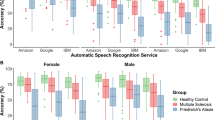Abstract
The spread of voice-driven devices has a positive impact for people with disabilities in smart environments, since such devices allow them to perform a series of daily activities that were difficult or impossible before. As a result, their quality of life and autonomy increase. However, the speech recognition technology employed in such devices becomes limited with people having communication disorders, like dysarthria. People with dysarthria may be unable to control their smart environments, at least with the needed proficiency; this problem may negatively affect the perceived reliability of the entire environment. By exploiting the TORGO database of speech samples pronounced by people with dysarthria, this paper compares the accuracy of the dysarthric speech recognition as achieved by three speech recognition cloud platforms, namely IBM Watson Speech-to-Text, Google Cloud Speech, and Microsoft Azure Bing Speech. Such services, indeed, are used in many virtual assistants deployed in smart environments, such as Google Home. The goal is to investigate whether such cloud platforms are usable to recognize dysarthric speech, and to understand which of them is the most suitable for people with dysarthria. Results suggest that the three platforms have comparable performance in recognizing dysarthric speech and that the accuracy of the recognition is related to the speech intelligibility of the person. Overall, the platforms are limited when the dysarthric speech intelligibility is low (80–90% of word error rate), while they improve up to reach a word error rate of 15–25% for people without abnormality in their speech intelligibility.

Similar content being viewed by others
Explore related subjects
Discover the latest articles and news from researchers in related subjects, suggested using machine learning.References
Ballati F, Corno F, De Russis L (2018) Assessing virtual assistant capabilities with italian dysarthric speech. In: Proceedings of the 20th international ACM SIGACCESS conference on computers and accessibility, ASSETS ’18, ACM, New York, pp 93–101. https://doi.org/10.1145/3234695.3236354
Ballati F, Corno F, De Russis L (2018) Hey siri, do you understand me?: Virtual assistants and dysarthria. In: Intelligent environments 2018: workshop proceedings of the 14th international conference on intelligent environments, IOS Press, Amsterdam, pp. 557–566. https://doi.org/10.3233/978-1-61499-874-7-557
Bigham JP, Kushalnagar R, Huang THK, Flores JP, Savage S (2017) On how deaf people might use speech to control devices. In: Proceedings of the 19th international ACM SIGACCESS conference on computers and accessibility-ASSETS’17. ACM Press. https://doi.org/10.1145/3132525.3134821
DeRosier R, Farber RS (2005) Speech recognition software as an assistive device: a pilot study of user satisfaction and psychosocial impact. Work 25(2):125–134
Enderby P (1980) Frenchay dysarthria assessment. Int J Lang Commun Disord 15(3):165–173. https://doi.org/10.3109/13682828009112541
Glasser AT, Kushalnagar KR, Kushalnagar RS (2017) Feasibility of using automatic speech recognition with voices of deaf and hard-of-hearing individuals. In: Proceedings of the 19th international ACM SIGACCESS conference on computers and accessibility-ASSETS’17. ACM Press. https://doi.org/10.1145/3132525.3134819
Google (2018) Cloud speech-to-text. https://cloud.google.com/speech-to-text/. Accessed 15 May 2019
Hawley MS (2002) Speech recognition as an input to electronic assistive technology. Br J Occup Therap 65(1):15–20. https://doi.org/10.1177/030802260206500104
IBM (2018) Watson speech to text. https://www.ibm.com/cloud/watson-speech-to-text. Accessed 15 May 2019
Joy NM, Umesh S (2018) Improving acoustic models in torgo dysarthric speech database. IEEE Trans Neural Syst Rehabil Eng 26(3):637–645. https://doi.org/10.1109/TNSRE.2018.2802914
Kent RD (2000) Research on speech motor control and its disorders: a review and prospective. J Commun Disord 33:391–427 quiz 428
Kim H, Hasegawa-Johnson M, Perlman A, Gunderson J, Huang T, Watkin K, Frame S (2008) Dysarthric speech database for universal access research. In: Interspeech, pp 1741–1744
Kim M, Kim Y, Yoo J, Wang J, Kim H (2017) Regularized speaker adaptation of kl-hmm for dysarthric speech recognition. IEEE Trans Neural Syst Rehabil Eng 25(9):1581–1591. https://doi.org/10.1109/TNSRE.2017.2681691
Kim M, Wang J, Kim H (2016) Dysarthric speech recognition using kullback-leibler divergence-based hidden markov model. In: Interspeech 2016, pp 2671–2675. https://doi.org/10.21437/Interspeech.2016-776
Koester HH (2004) Usage, performance, and satisfaction outcomes for experienced users of automatic speech recognition. J Rehabil Res Dev 41(5):739. https://doi.org/10.1682/jrrd.2003.07.0106
Menendez-Pidal X, Polikoff JB, Peters SM, Leonzio JE, Bunnell HT (1996) The nemours database of dysarthric speech. In: Proceeding of 4th international conference on spoken language processing. ICSLP ’96, 3:1962–1965. https://doi.org/10.1109/ICSLP.1996.608020
Microsoft (2018) Bing speech. https://azure.microsoft.com/en-us/services/cognitive-services/speech/. Accessed 15 May 2019
Pradhan A, Mehta K, Findlater L (2018) “Accessibility came by accident”: use of voice-controlled intelligent personal assistants by people with disabilities. In: Proceedings of the 2018 CHI conference on human factors in computing systems, CHI ’18, pp 459:1–459:13. ACM, New York, NY. https://doi.org/10.1145/3173574.3174033
Rudzicz F (2012) Using articulatory likelihoods in the recognition of dysarthric speech. Speech Commun 54(3):430–444. https://doi.org/10.1016/j.specom.2011.10.006
Rudzicz F, Namasivayam AK, Wolff T (2012) The TORGO database of acoustic and articulatory speech from speakers with dysarthria. Lang Resour Evaluat 46(4):523–541. https://doi.org/10.1007/s10579-011-9145-0
Yu J, Xie X, Liu S, Hu S, Lam MWY, Wu X, Wong KH, Liu X, Meng H (2018) Development of the cuhk dysarthric speech recognition system for the ua speech corpus. In: Proceedings of Interspeech 2018, pp 2938–2942. https://doi.org/10.21437/Interspeech.2018-1541
Zue V, Seneff S, Glass J (1990) Speech database development at MIT: timit and beyond. Speech Commun 9(4):351–356. https://doi.org/10.1016/0167-6393(90)90010-7
Acknowledgements
The authors would like to thank Fabio Ballati for his contribution to the data analysis and for the software implementation to interact with each ASR cloud platform.
Author information
Authors and Affiliations
Corresponding author
Additional information
Publisher's Note
Springer Nature remains neutral with regard to jurisdictional claims in published maps and institutional affiliations.
Rights and permissions
About this article
Cite this article
De Russis, L., Corno, F. On the impact of dysarthric speech on contemporary ASR cloud platforms. J Reliable Intell Environ 5, 163–172 (2019). https://doi.org/10.1007/s40860-019-00085-y
Received:
Accepted:
Published:
Issue Date:
DOI: https://doi.org/10.1007/s40860-019-00085-y




